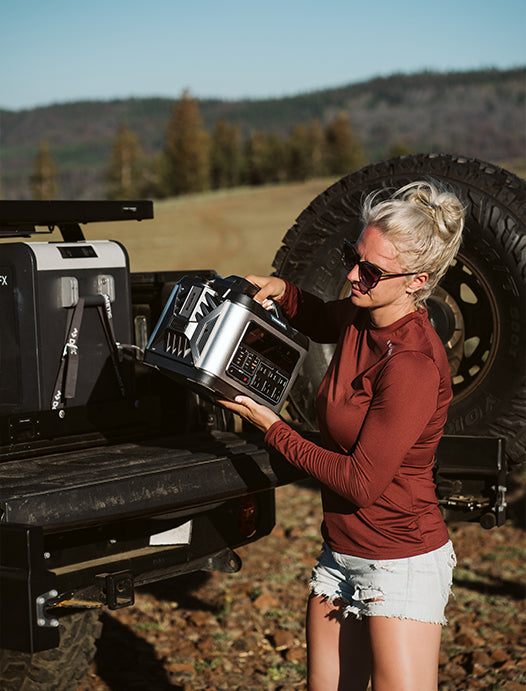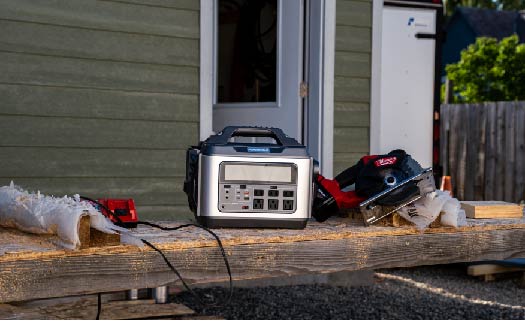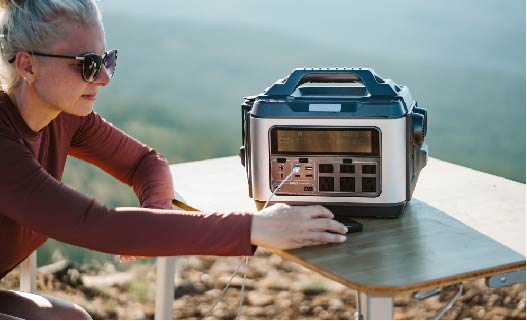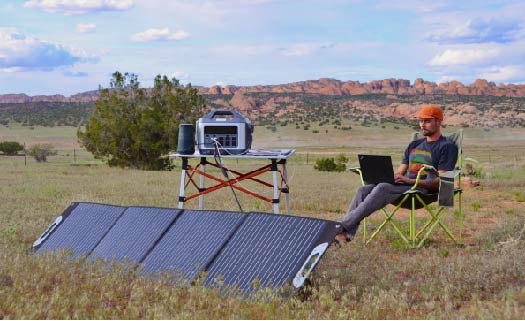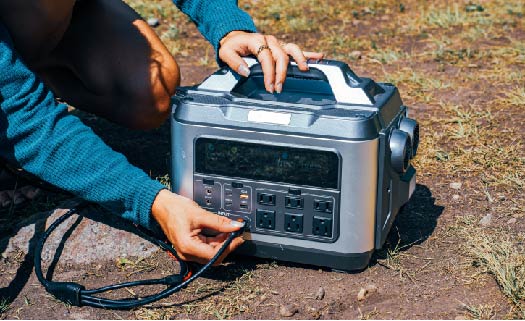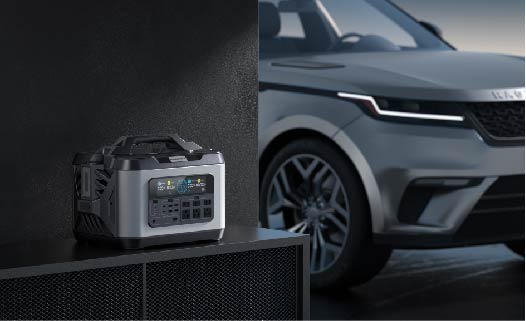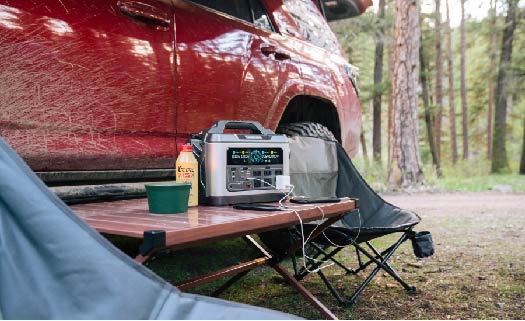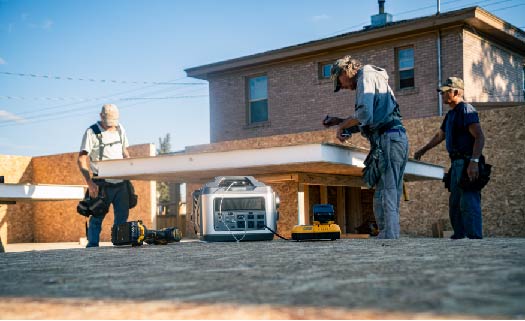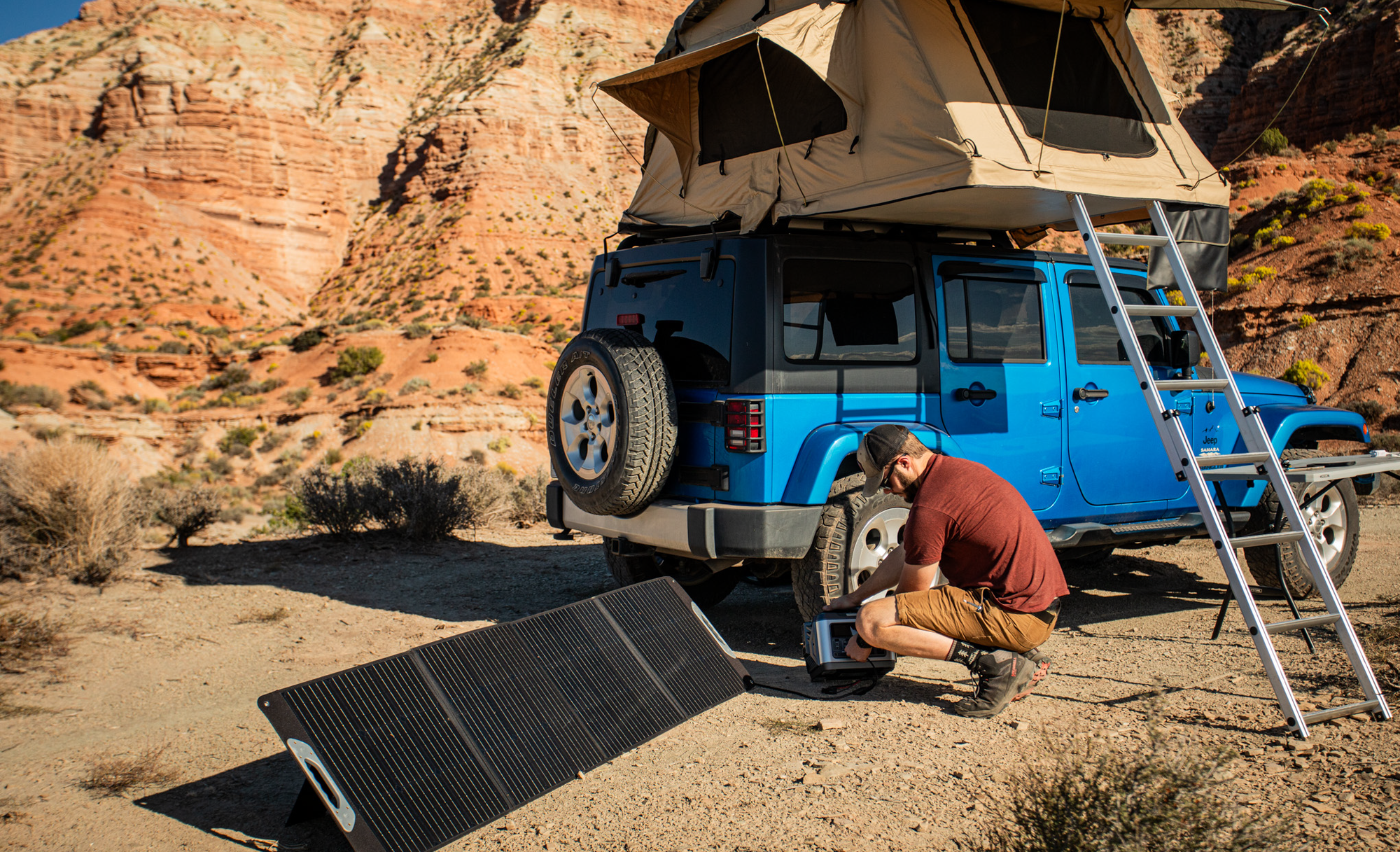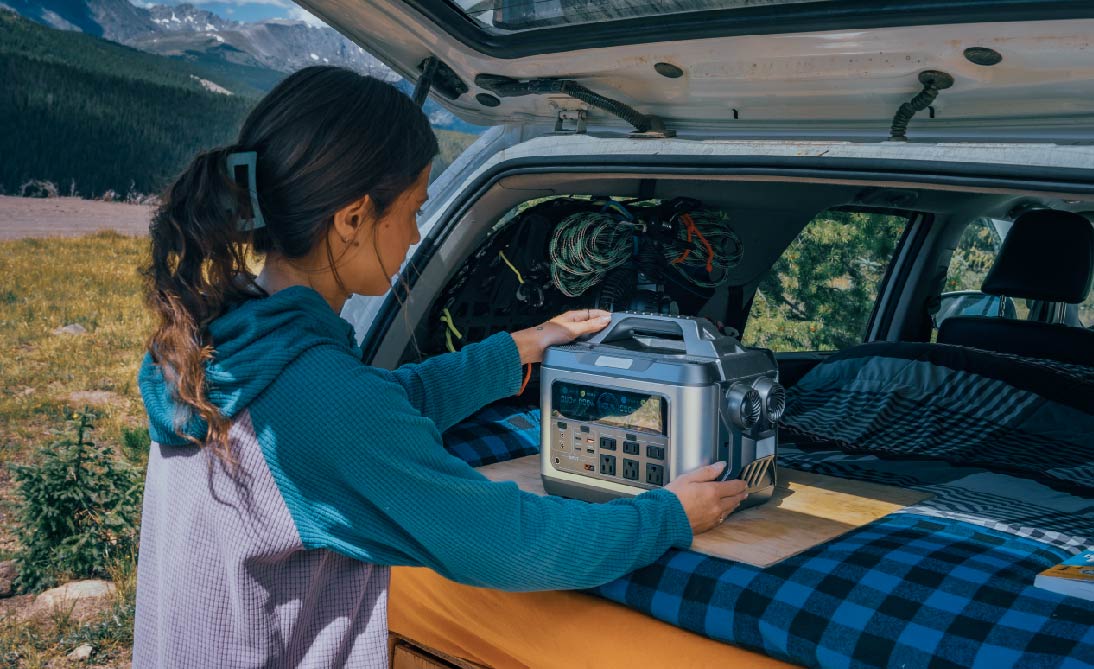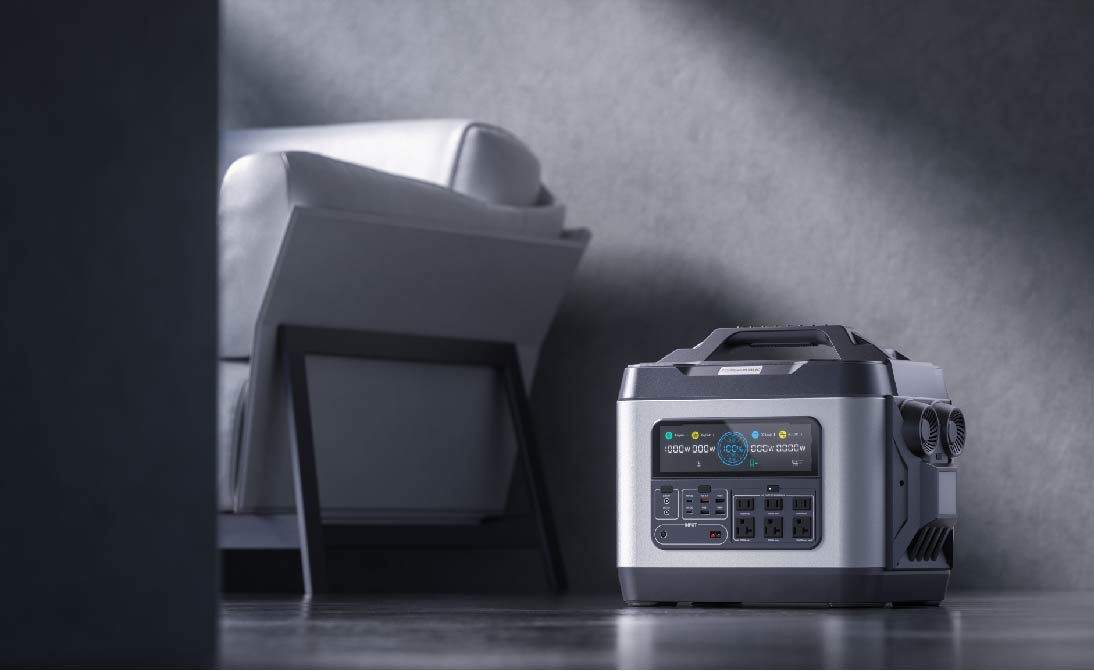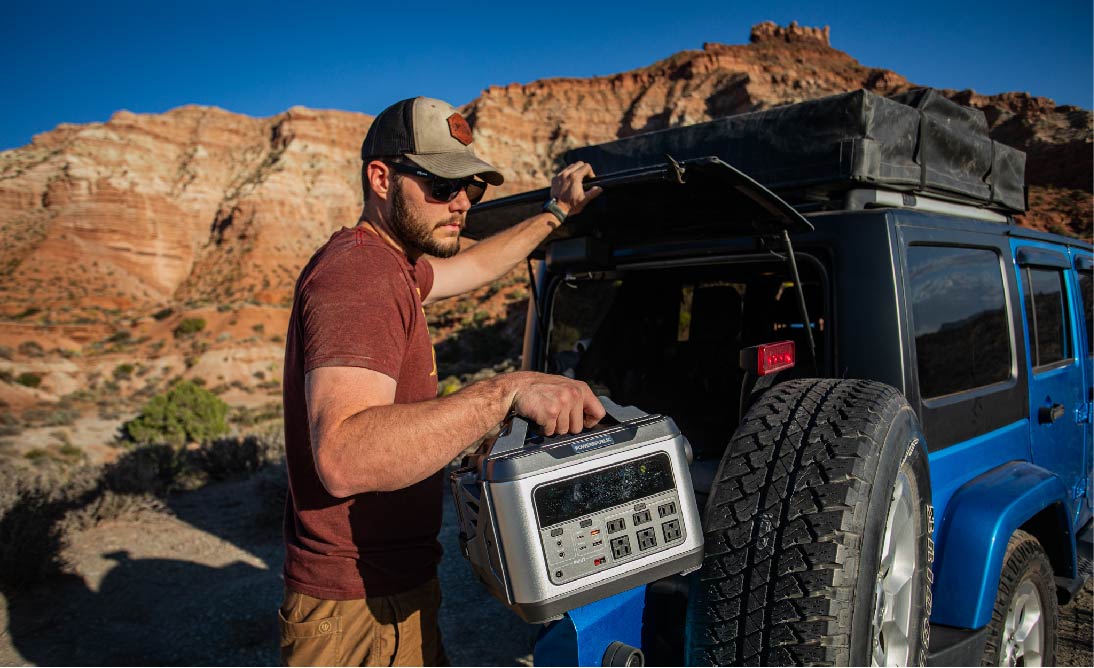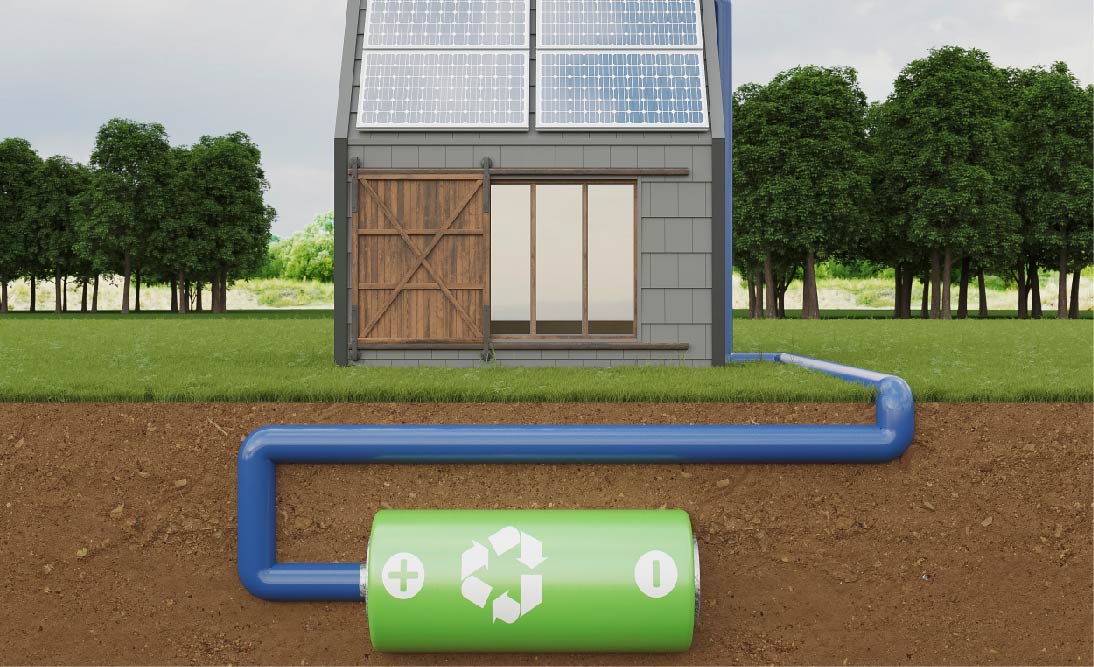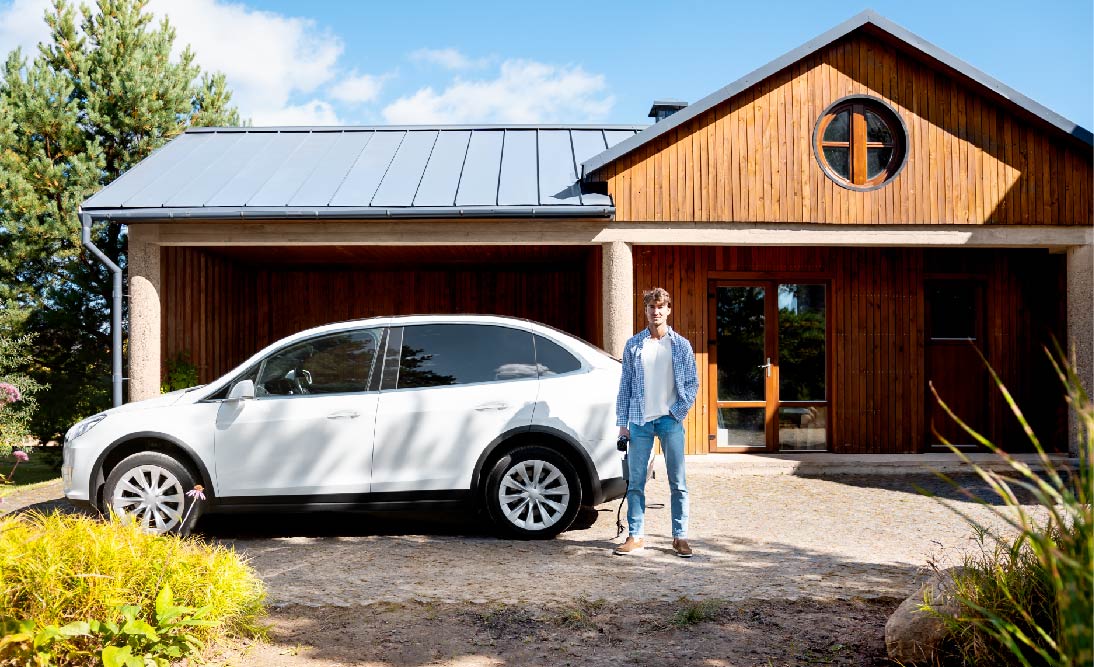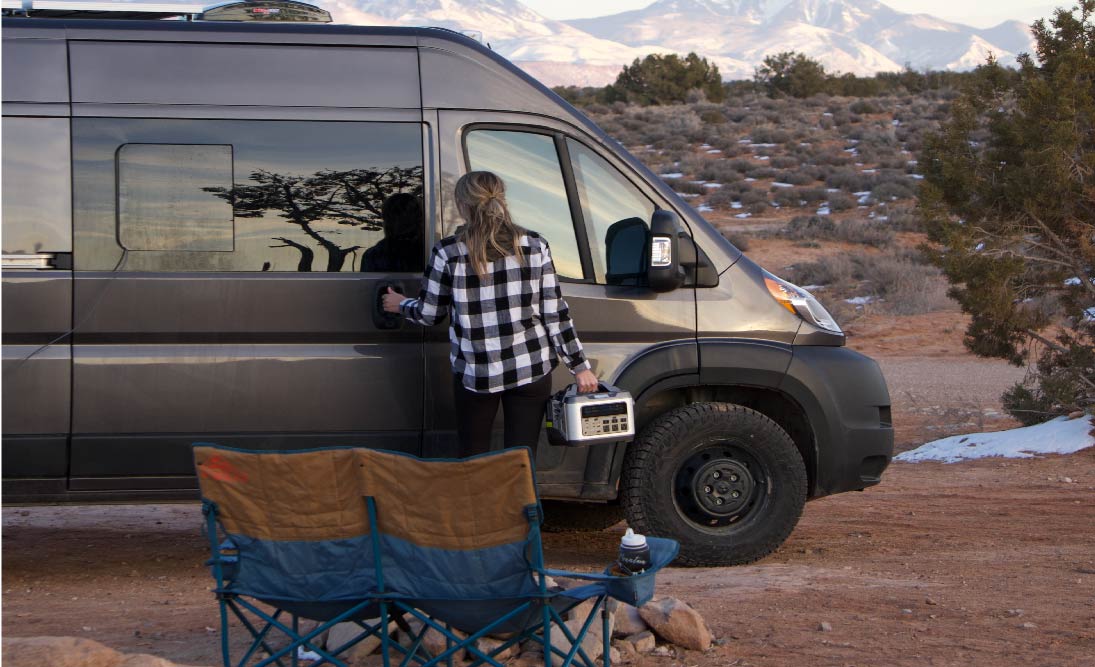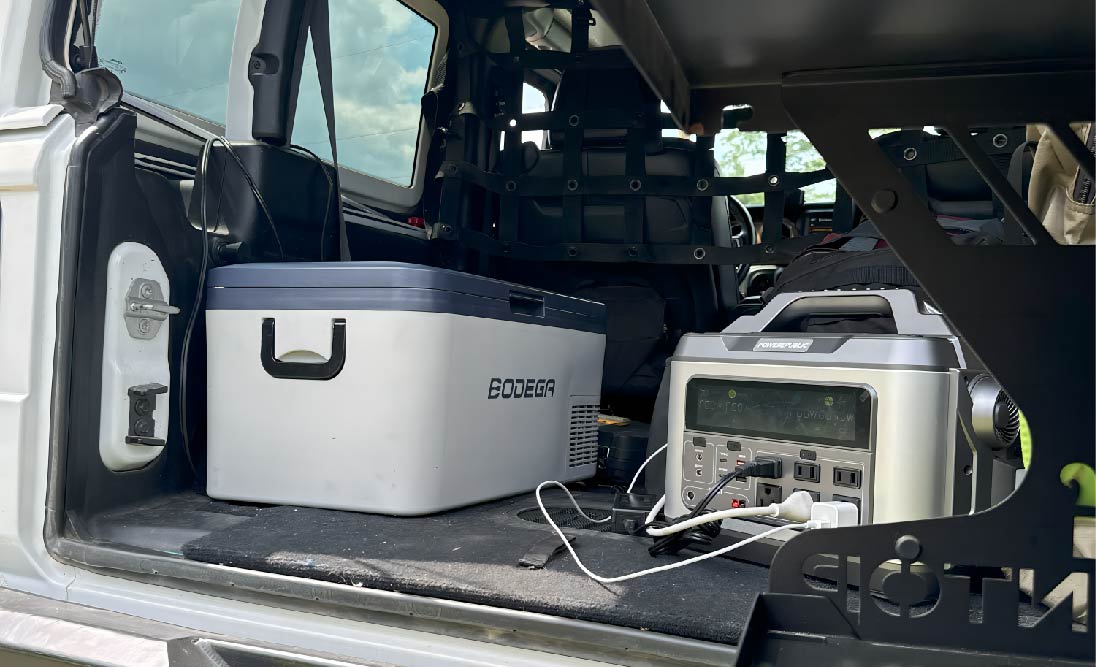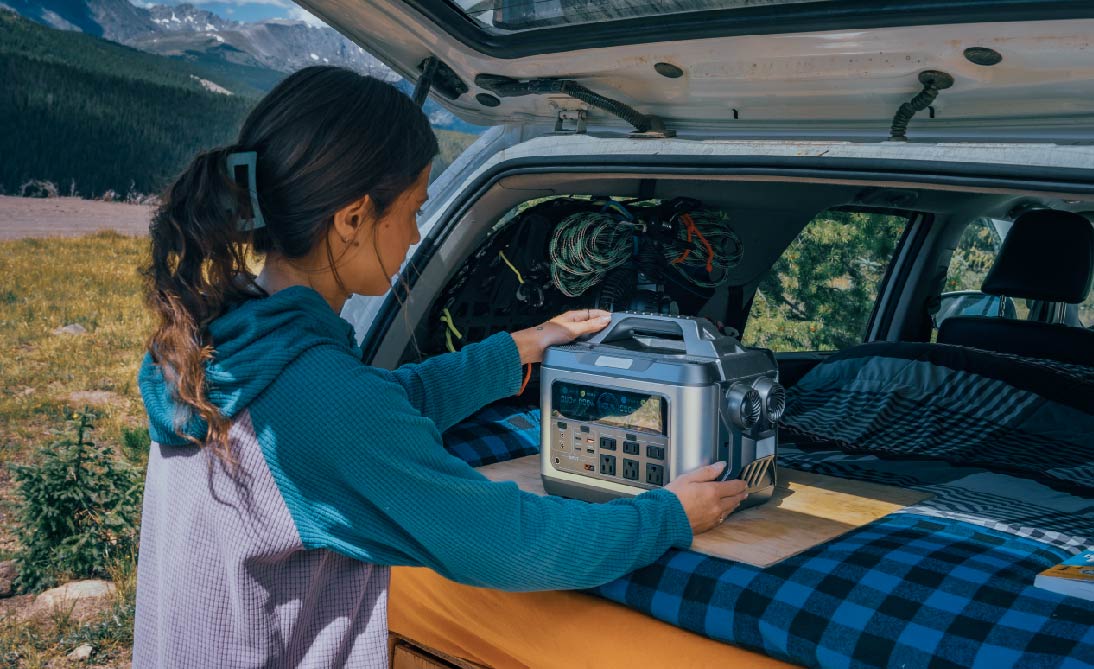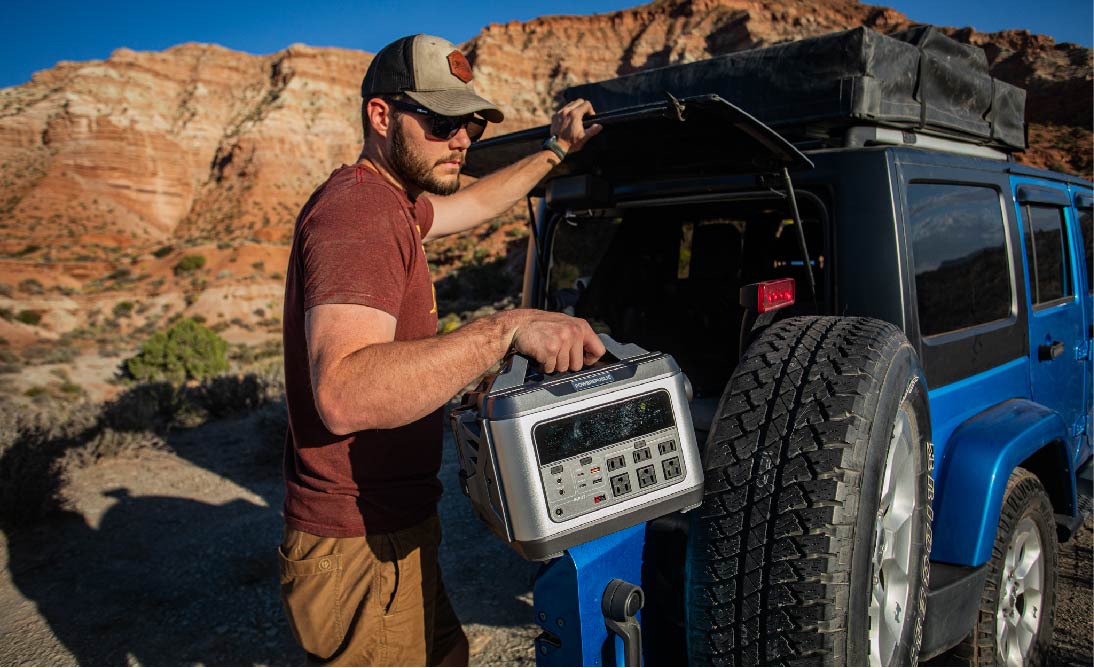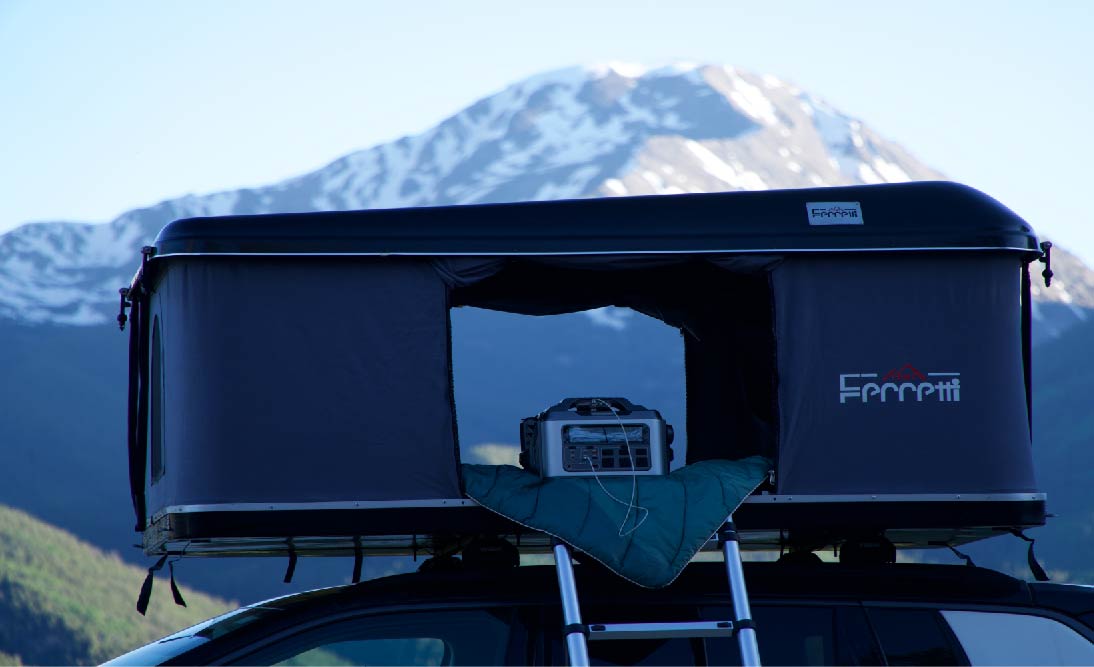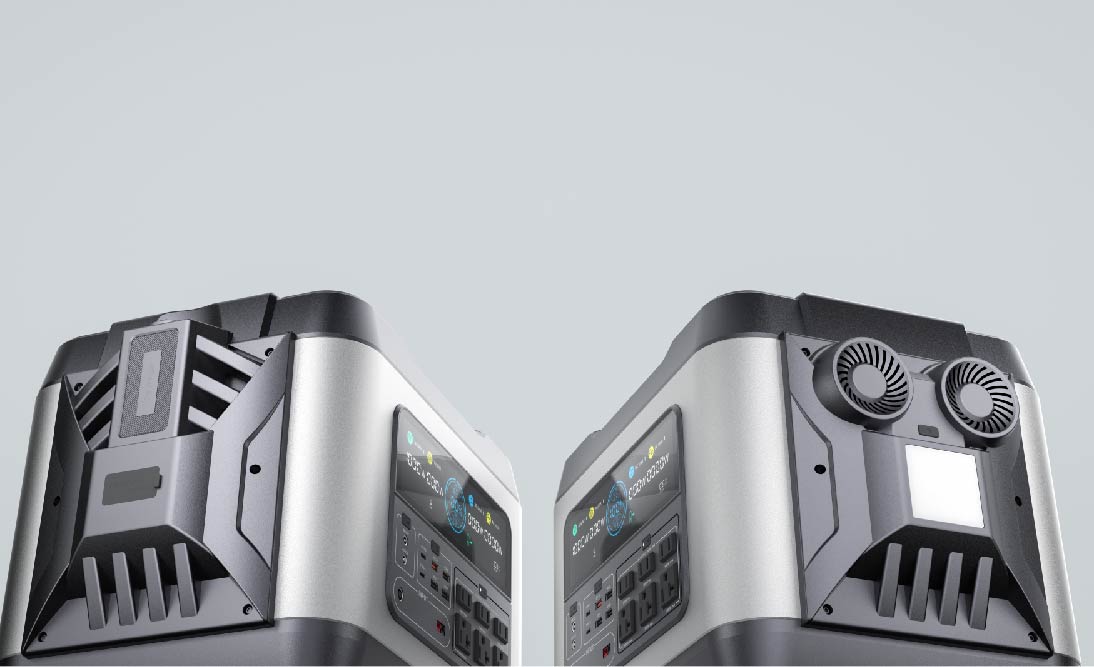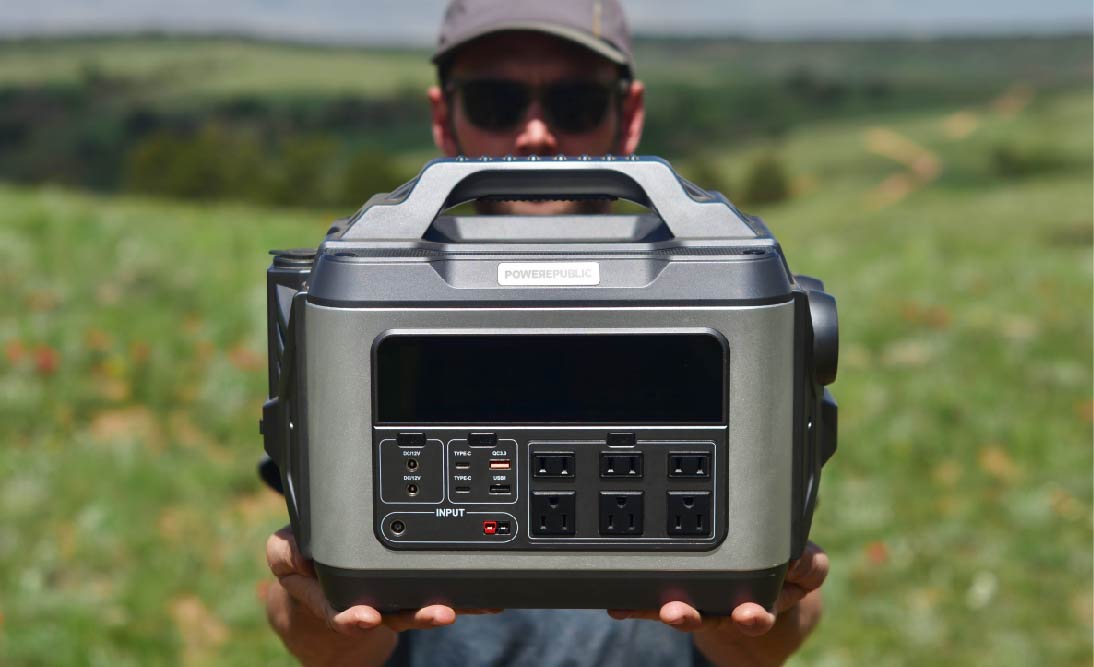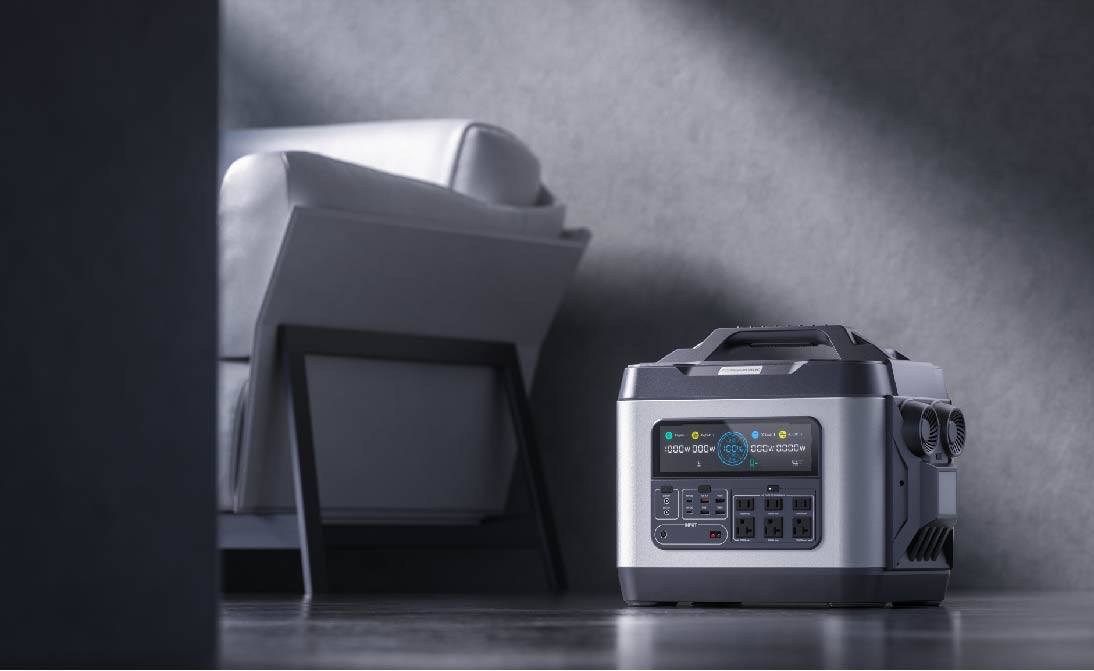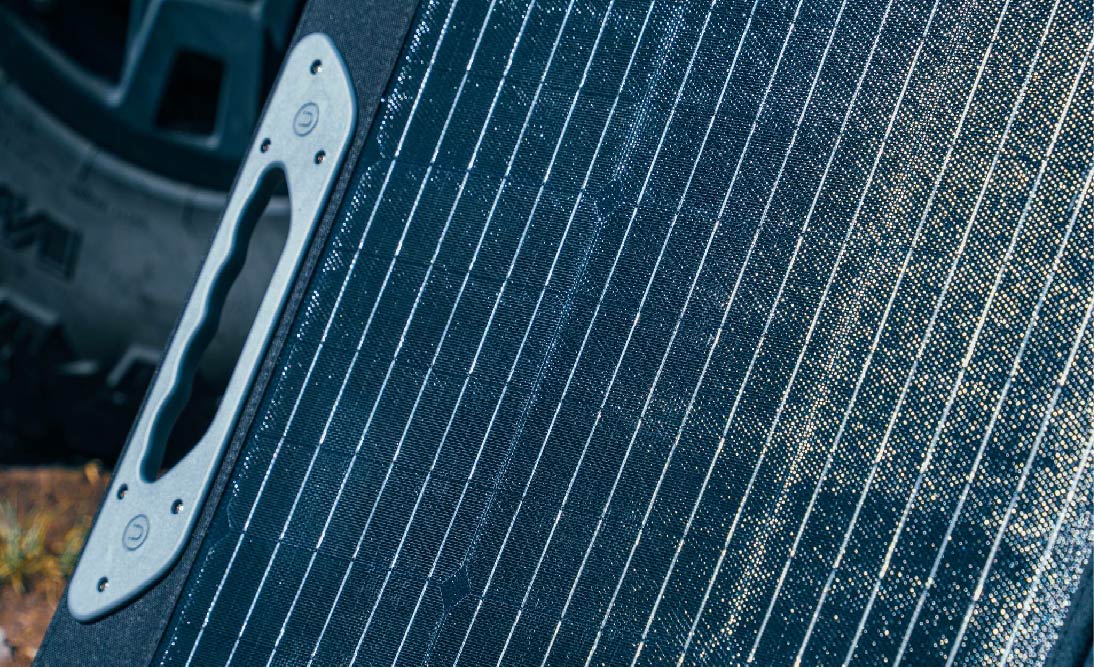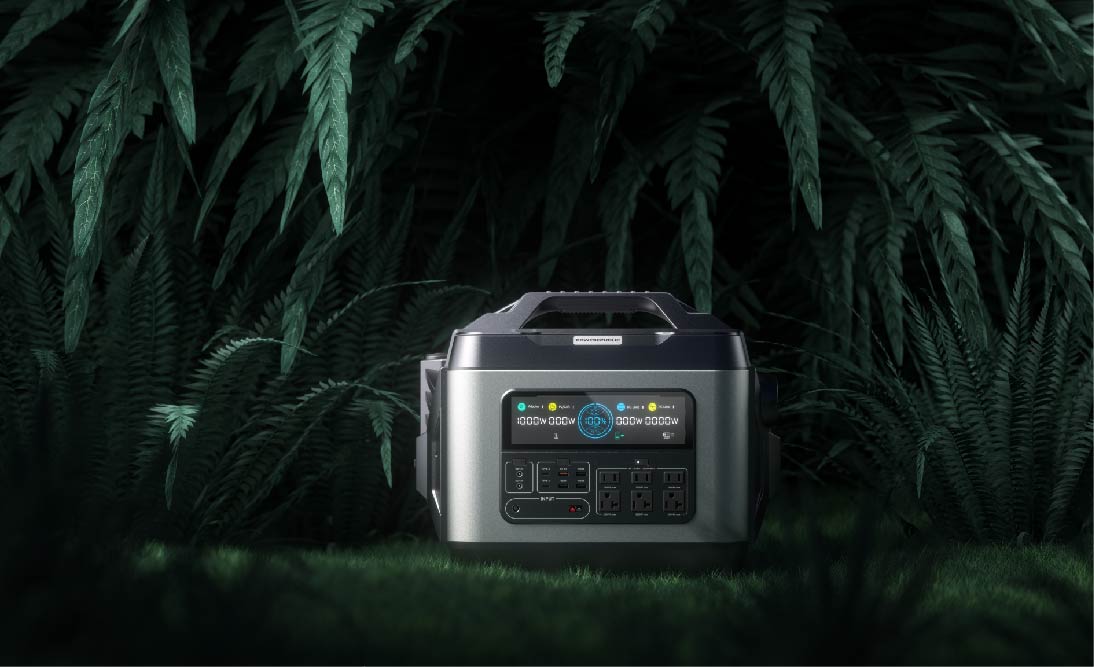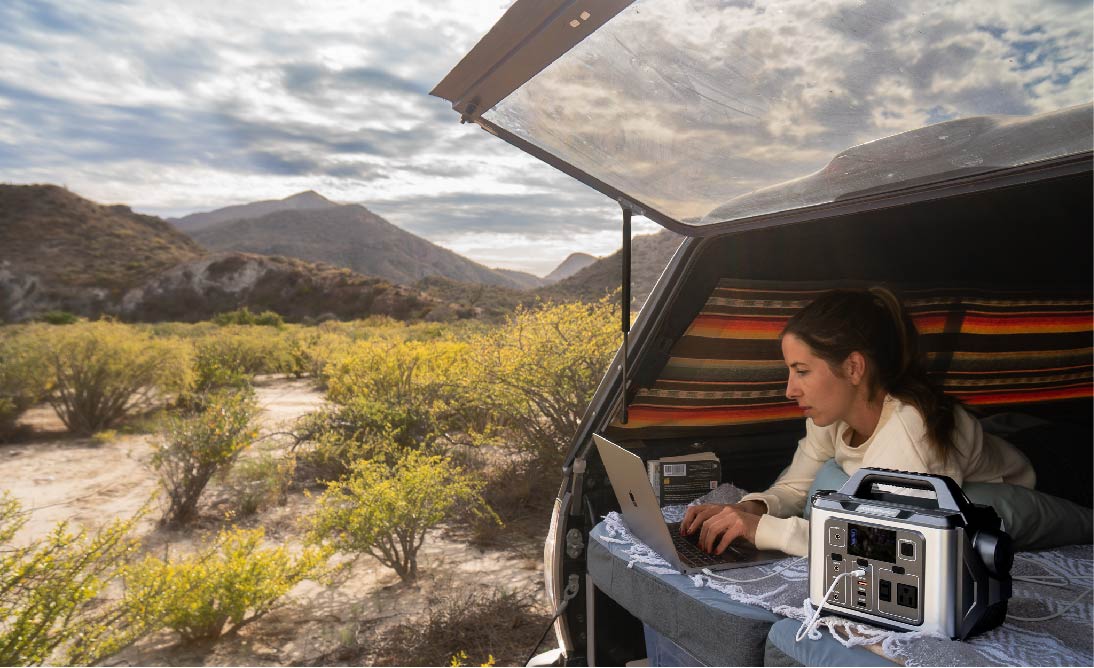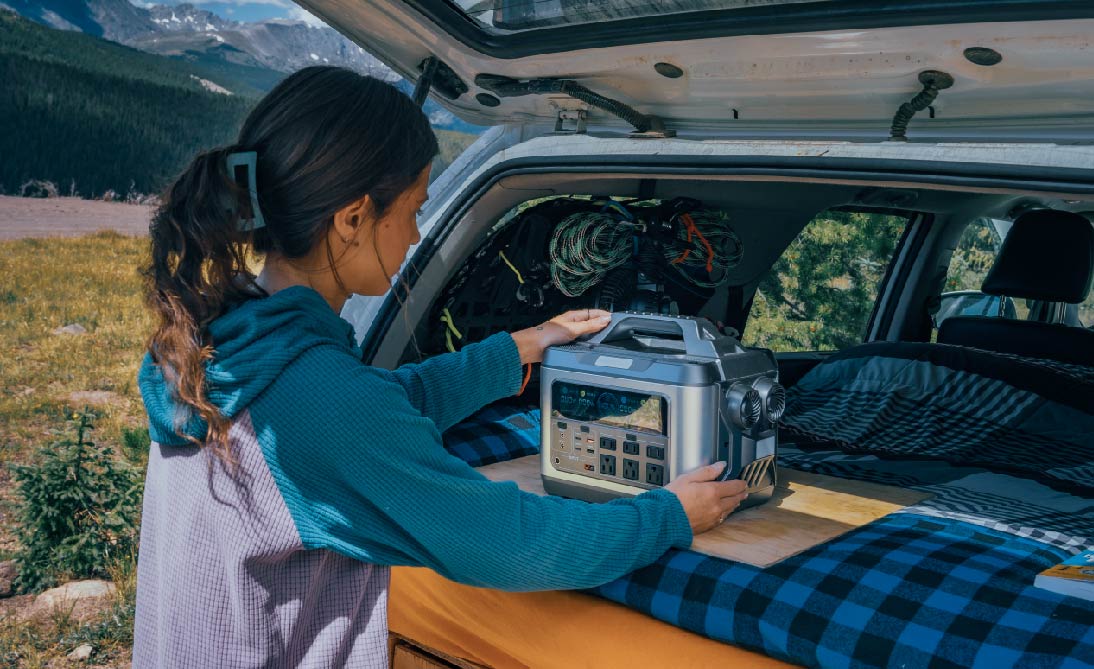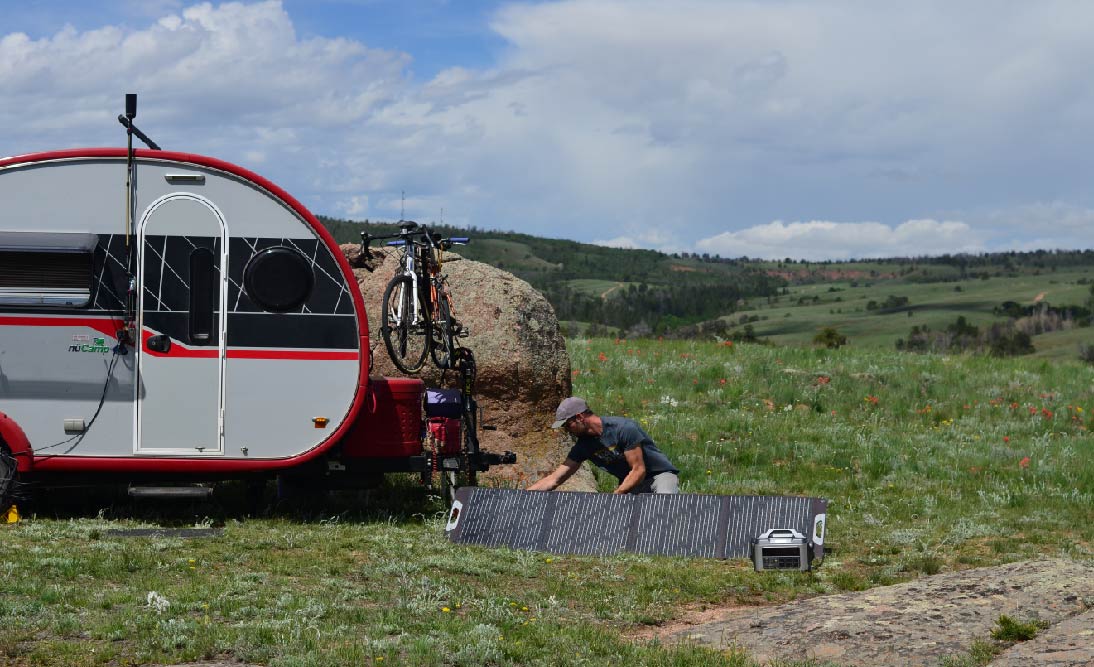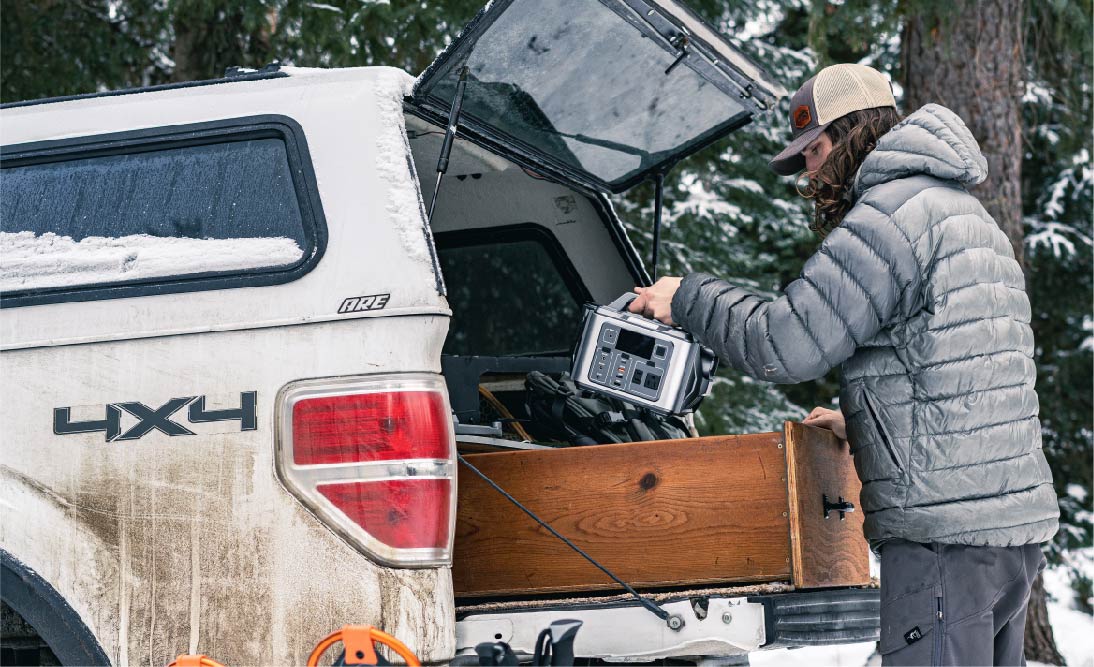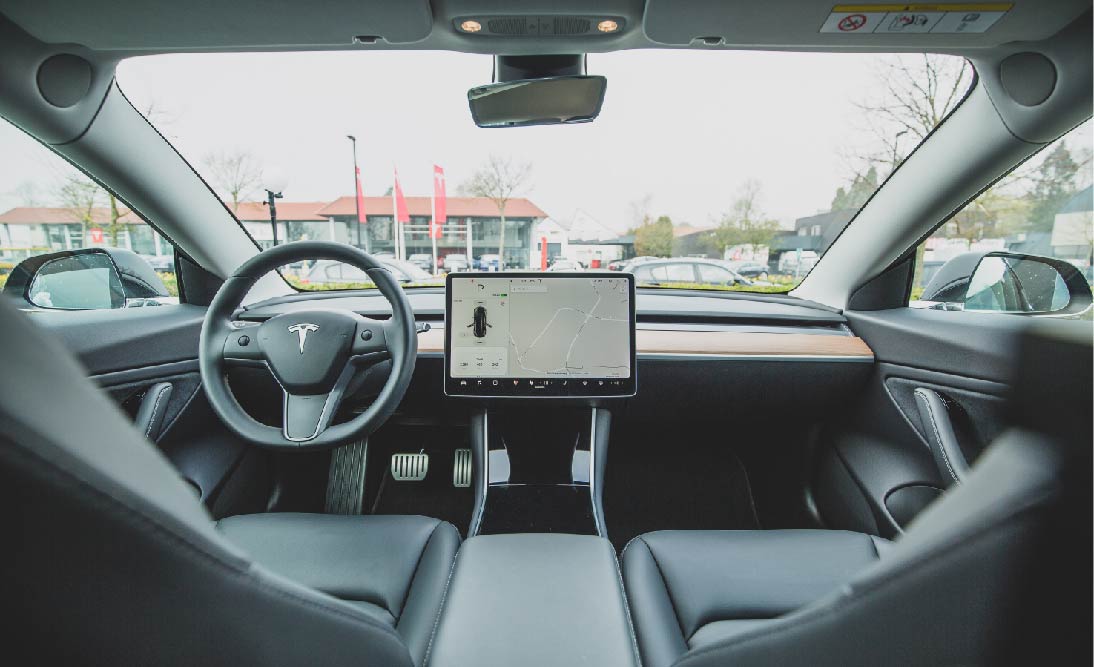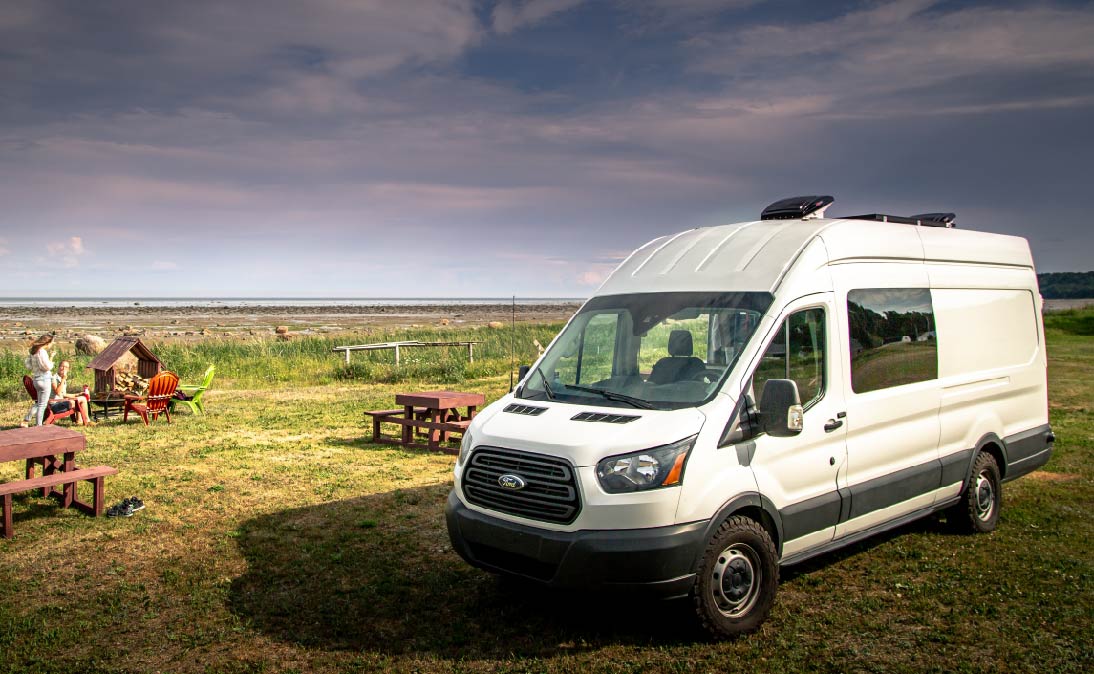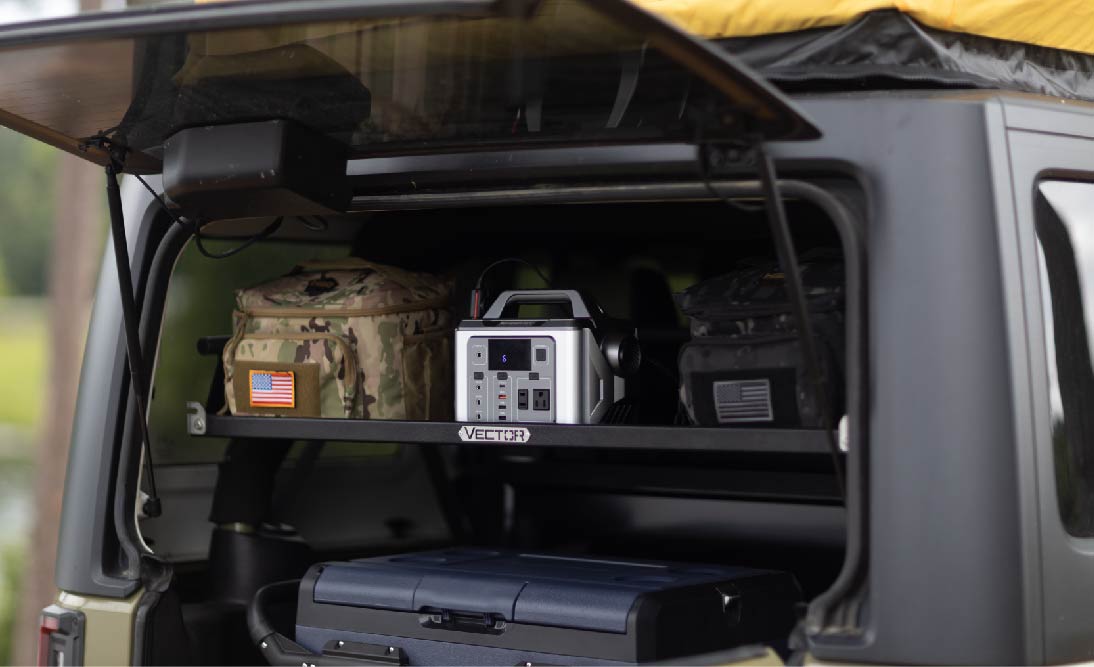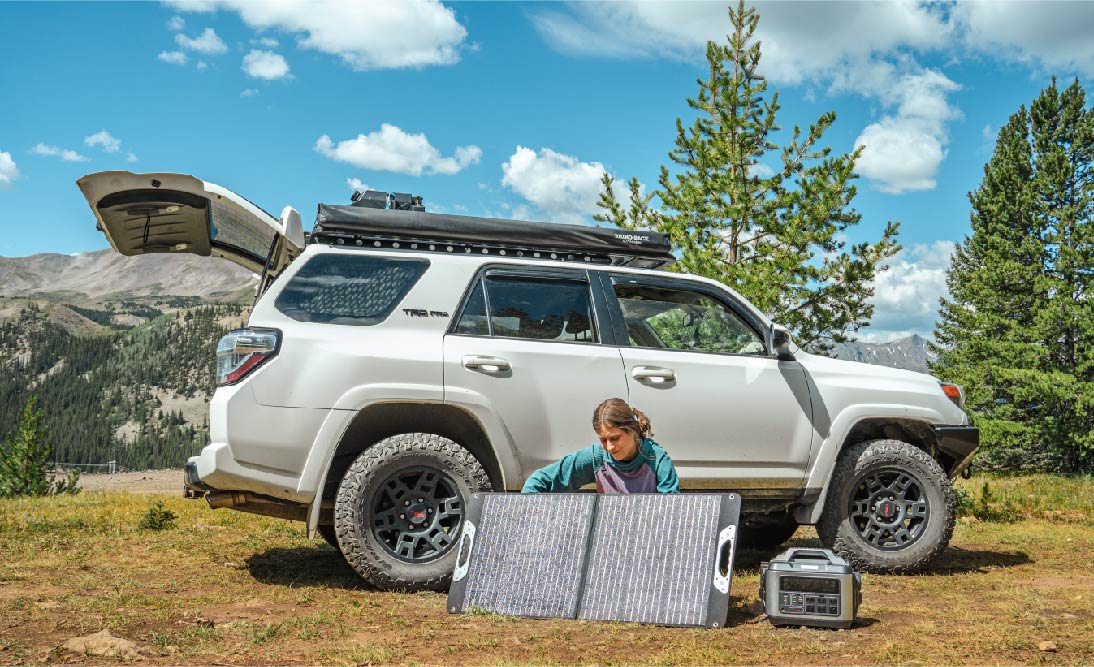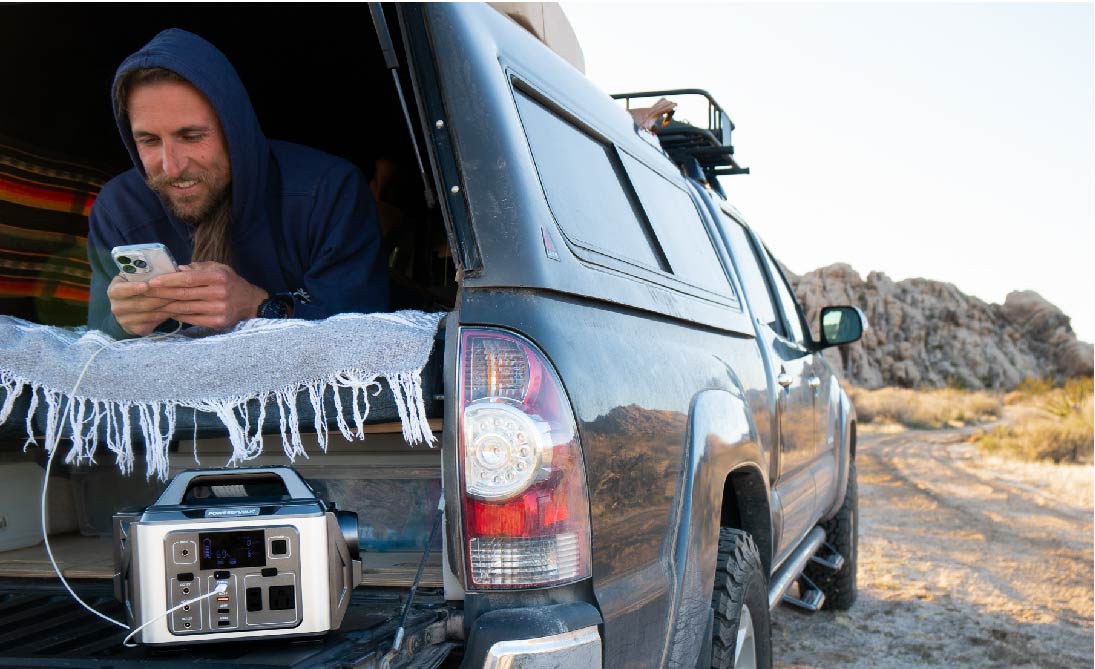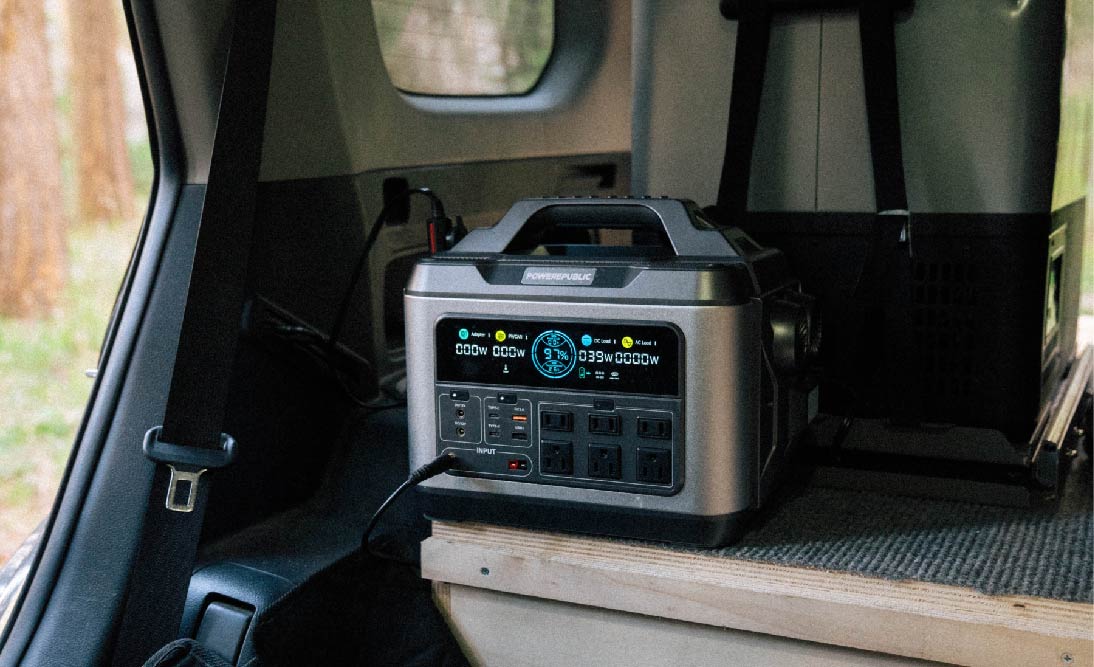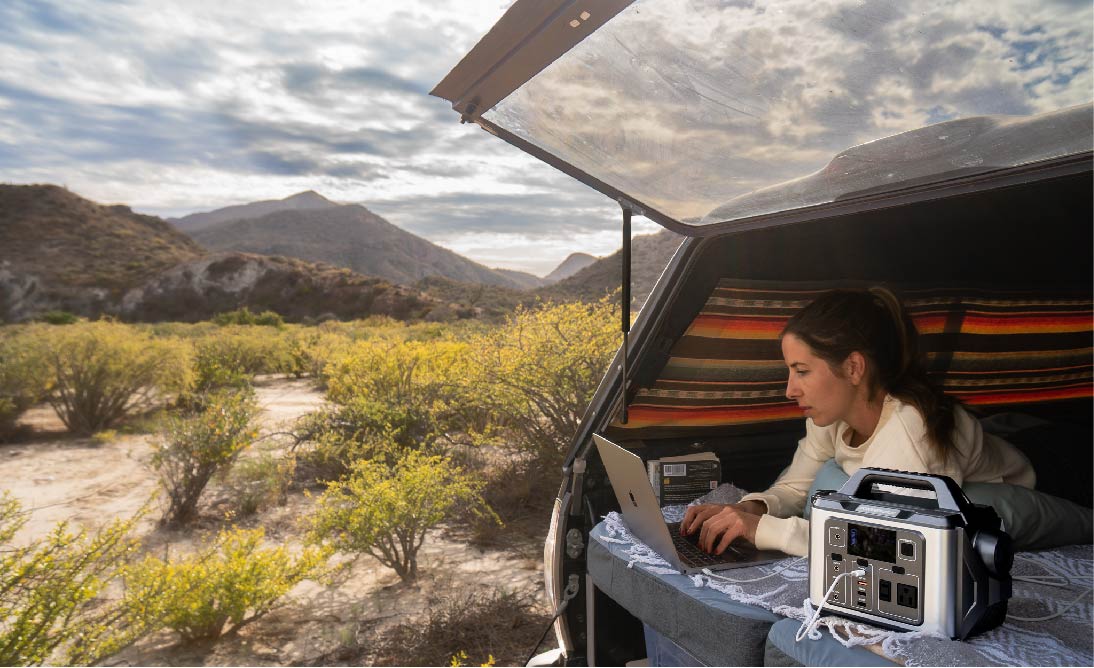Table of Contents:
Although many vans and RVs have solar systems for electricity, having a portable power station as a secondary battery for emergency backup is important, especially for campers who travel with their vehicles.
In this article, we are going to talk about what a portable power station is, introduce the POWEREPUBLIC 1000W portable power station and its functionality, and discuss how to select the best portable power station. We hope you find this article informative after reading it.
What is a Portable Power Station?

You can imagine a portable power station as a giant power bank.
A portable power station is a compact, self-contained device designed to generate and store electrical energy for various applications. Unlike traditional generators, portable power stations typically utilize advanced battery technology to store power and provide a clean and silent alternative for powering electronic devices, appliances, and tools. They are commonly used in outdoor activities, camping, emergencies, and situations where access to a traditional power source is limited.
Main Components of a Portable Power Station:
1. Battery Pack
-
Type: Portable power stations use high-capacity rechargeable batteries, often lithium-ion or lithium-polymer, due to their high energy density and relatively lightweight characteristics.
-
Capacity: Measured in watt-hours (Wh) or ampere-hours (Ah), the battery capacity dictates the amount of energy that the power station is capable of storing.
2. Inverter
-
Function: Converts the direct current (DC) electricity stored in the battery into alternating current (AC) electricity, which is the standard form used by most household appliances and electronic devices.
-
Output Waveform: Inverters may produce a pure sine wave, modified sine wave, or square wave. Pure sine wave inverters provide a clean and stable power output suitable for sensitive electronics.
3. Charge Controller
-
Function: Manages the charging process of the battery to ensure efficient and safe charging. It regulates the flow of electrical energy from the power source to prevent overcharging, which can damage the battery.
-
Solar Charging: In models designed for solar charging, the charge controller facilitates the connection and charging from solar panels.
4. DC Output Ports
-
Types: Portable power stations typically include various DC output ports, such as USB ports, 12V car sockets, and other proprietary connectors.
-
Function: These ports allow users to directly power or charge devices that operate on DC power, such as smartphones, laptops, cameras, and camping equipment.
5. AC Outlets
-
Type: Similar to the electrical outlets found in homes, portable power stations feature AC outlets.
-
Function: AC outlets enable the connection of standard household appliances and electronic devices, offering a versatile power source for a range of equipment.
6. Input Ports
-
Types: Portable power stations can be charged through multiple sources, and input ports vary accordingly. Common input ports include AC power input for wall charging, DC input for car charging, and solar input for solar charging.
7. Display and Controls
-
Display Screen: Shows important information such as battery status, input/output wattage, charging status, and other relevant data.
-
Controls: User interface for operating and configuring the portable power station. Controls may include buttons, switches, and settings for various functions.
Understanding these main components is crucial for users to assess the capabilities and suitability of a portable power station for their specific needs and applications.
Pros and Cons Of Portable Power Stations

For a better comparison of their benefit and drawbacks, we have made a chart. This chart provides a comprehensive overview of the advantages and disadvantages of portable power stations, helping users make informed decisions based on their specific requirements.
|
Pros of Portable Power Stations |
Cons of Portable Power Stations |
|
Portability: Easy to carry and transport. |
Limited Power Output: Not suitable for high-power applications. |
|
Silent Operation: Operates without noise. |
Dependency on Battery Capacity: Users need to manage battery levels. |
|
Clean Power Output: Suitable for sensitive electronics. |
Charging Time: Charging can take several hours. |
|
Eco-Friendly: Reduces reliance on fossil fuels. |
Initial Cost: Higher upfront cost compared to some alternatives. |
|
Multi-Device Charging: Multiple charging ports. |
Limited Solar Charging Efficiency: Efficiency depends on various factors. |
|
Low Maintenance: Fewer moving parts, lower maintenance. |
Temperature Sensitivity: Performance affected by extreme temperatures. |
|
Quick and Easy Setup: Simple deployment. |
Not Suitable for Heavy-Duty Applications: Limited power for large appliances. |
|
Versatility: Suitable for various applications. |
Limited Lifespan: Battery performance may degrade over time. |
POWEREPUBLIC 1000W Portable Power Station

POWEREPUBLIC T1200 Portable Power Station
For those of you who are searching for a 1000W portable power station that perfectly balances functionality, versatility, and portability, consider our T1200 portable power station.
-
Functionality: With a rated power of 1200W, surge power of 2600W, and an 1110Wh capacity, our T1200 is an ideal 1000W portable power station for camping, off-grid living, and any other outdoor events. It can power all your essential electronic devices, as well as larger items like TVs, mini-fridges, electric blankets, coffee machines, electric grills, and more.
-
Versatility: With 6 AC outlets, 2 Type-C ports, 1 QC 3.0 port, 1 USB port, 2 DC/12V ports, and a cigarette port, you can power up to 13 items at once. What's more, you can recharge our T1200 via AC adapters, your vehicle’s car sockets, and portable solar panels. You can choose based on your convenience.
-
Portability: Although our T1200 weighs around 31 lbs (14 kg), it is still quite portable with a battery capacity of 1110Wh. We won't claim our T1200 is the most portable 1000W power station, but it is an option that finds a balance between portability, functionality, and versatility.
Using a 1000W Portable Power Station For Camping - Product Review

We understand that portable power stations come with a certain cost. The larger the power output and battery capacity, the higher the price. To help you better understand what a 1000W portable power station can do, here is a link to a video created by Abby, who lives in a van and travels across the United States.
After watching the video, you will gain insights into the functionality and versatility of the POWEREPUBLIC T1200 Portable Power Station.
Using a 1000W Portable Power Station For Remote Working

One of the frequently asked questions for people on the road is how they can work and make money. With a 1000W portable power station, you can set up your workplace anywhere you like by keeping your laptops, Starlinks, and cell phones charged on the move. By doing this, you can work wherever you go and stay connected to brands and projects.
-
If you want to know more about using a 1000W portable power station for remote working, here is a link to a video that explains how to do so using our T1200 model.
-
If you want to know more about using a 1000W portable power station for heavy-duty tools, here is a link to a video that explains how to do so using our T1200 model.
Using a 1000W Portable Power Station For Outdoor Cooking

With a 1000W portable power station by your side, you can set up your kitchen anywhere. Most kitchen appliances range from 100W to 1200W, such as electric grills, induction cookers, and coffee machines. With the POWEREPUBLIC T1200 model, you can power almost 90% of kitchen appliances.
-
If you want to know more about using a 1000W portable power station for making Ravioli, here is a link to a video that explains how to do so using our T1200 model.
-
If you're interested in using a 1000W portable power station for making popcorn, here is a link to a video that explains how to do so with our T1200 model.
Using a 1000W Portable Power Station For Electrical Blanket

When winter camping, it is important to stay warm. Most heaters range from 800W to 2000W. If you use a 1000W portable power station, the battery will be drained within 1 or 2 hours. So, we wouldn't recommend that. However, if you use an electric blanket (80-110W), our T1200 can power it for at least 6 to 8 hours.
-
If you want to know more about using a 1000W portable power station to power an electric blanket, here is a link to a video by Madison that explains how to do so using our T1200 model.
Using a 1000W Portable Power Station For TVs

Can a portable power station power a TV? The answer is YES. However, if you want to power a TV for a couple of hours, please make sure to find out the wattage of your TV so that you can estimate how long a 1000W portable power station can power it. It is hard to give a general estimate of the time because many TVs have different wattages. If you want to power a 100W TV for 4 hours, choose a portable power station with at least 800Wh so that you can charge other devices at the same time.
-
If you want to know more about using a 1000W portable power station to power a TV (96W), here is a link to a video explaining how to do so using our T1200 model.
How To Select The Best Portable Power Stations?

Selecting the best portable power station involves considering various factors, including your power needs, battery capacity, portability, input/output options, and additional features. Here's a detailed guide to help you make an informed decision:
1. Power Requirements
-
Determine Your Wattage Needs: List all the devices you plan to power and their wattage requirements. Include essential devices like laptops(50W), smartphones(10W), LED lights(15W), and possibly larger appliances like mini-fridges or CPAP machines.
-
Add them together to get the total power. In this case, the total power would be 50W+10W+15W=75W.
2. Battery Capacity
-
Calculate Energy Requirements: Convert your daily wattage needs to watt-hours (Wh) by multiplying the daily wattage by the number of hours you plan to use the devices.
-
Consider Extra Capacity: Choose a power station with a capacity slightly higher than your calculated watt-hours to account for energy losses and ensure a safety margin.
-
Daily Wattage Needs: Laptop (50W) + Smartphone (10W) + LED Light (15W) = 75W
-
Daily Watt-Hours: 75W * 6 hours = 450Wh
-
Recommended Capacity: Choose a power station with a capacity of at least 500Wh.
3. Portability
-
Weight and Size: If you plan to carry the power station on hikes or camping trips, consider a lightweight and compact option. For home use during emergencies, a larger unit may be acceptable.
-
Handle and Wheels: Some larger units come with handles or wheels for easier transport.
4. Input/Output Options
-
AC Outlets: Ensure the power station has sufficient AC outlets for your devices. Consider the wattage limit of each outlet.
-
DC Outputs: Check for USB ports, DC ports, and other outputs. Ensure they match the requirements of your devices.
-
Solar Input: If you plan to recharge using solar panels, verify that the power station has a compatible input.
5. Charging Time
-
Input Power: Look at the input power rating, usually in watts. A higher input power allows for faster recharging.
-
Charging Source: Consider the various charging methods (wall outlet, car, solar) and their corresponding charging times.
6. Inverter Type
-
Pure Sine Wave vs. Modified Sine Wave: Pure sine wave inverters produce clean power that is compatible with sensitive electronics. On the other hand, modified sine wave inverters, while more budget-friendly, may lead to compatibility issues with certain devices.
7. Additional Features
-
Battery Management System (BMS): A BMS helps protect the battery from overcharging, over-discharging, and short circuits.
-
LCD Display: Provides information on battery level, input/output power, and other important metrics.
-
Inverter Efficiency: Higher efficiency means less energy loss during power conversion.
8. Brand Reputation and Reviews
-
Research Brands: Look for reputable brands known for producing reliable power stations.
-
Read Reviews: Check user reviews for real-world experiences with specific models.
9. Cost
-
Consider Value: While cost is a factor, prioritize value over the cheapest option. A higher-quality power station may provide better performance and durability.
By carefully considering these factors and performing the necessary calculations, you can select a portable power station that meets your specific needs and provides reliable power in various situations.
Final Thoughts
In conclusion, the 1000W portable power station, exemplified by the POWEREPUBLIC T1200, stands as a versatile energy solution for diverse applications. Its robust functionality, balanced with an 1110Wh capacity, caters to camping, remote working, outdoor cooking, and powering various electronic devices. The T1200's multiple output ports and recharging options, coupled with a manageable weight for its capacity, strike a harmonious balance between portability and performance.
Real-world scenarios, such as van life and remote work, demonstrate the practicality of a 1000W power station. The guide on selecting the best portable power stations underscores the significance of power needs, battery capacity, and other considerations, empowering users to make informed decisions tailored to their requirements. As demand grows for reliable and efficient portable power, the 1000W category emerges as a key player, offering a dynamic and accessible solution for users in both indoor and outdoor settings.
Explore POWEREPUBLIC Portable Power Stations.
